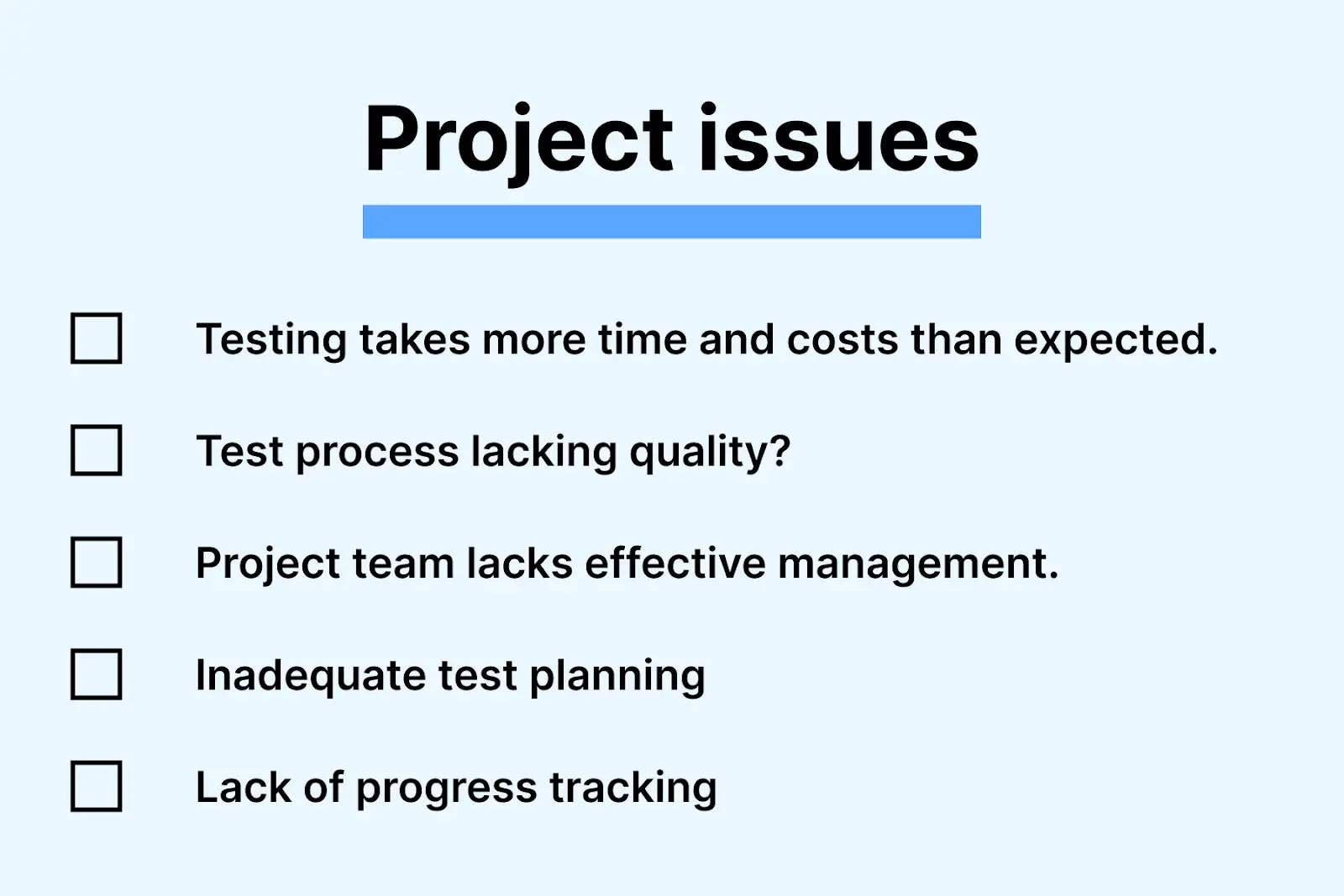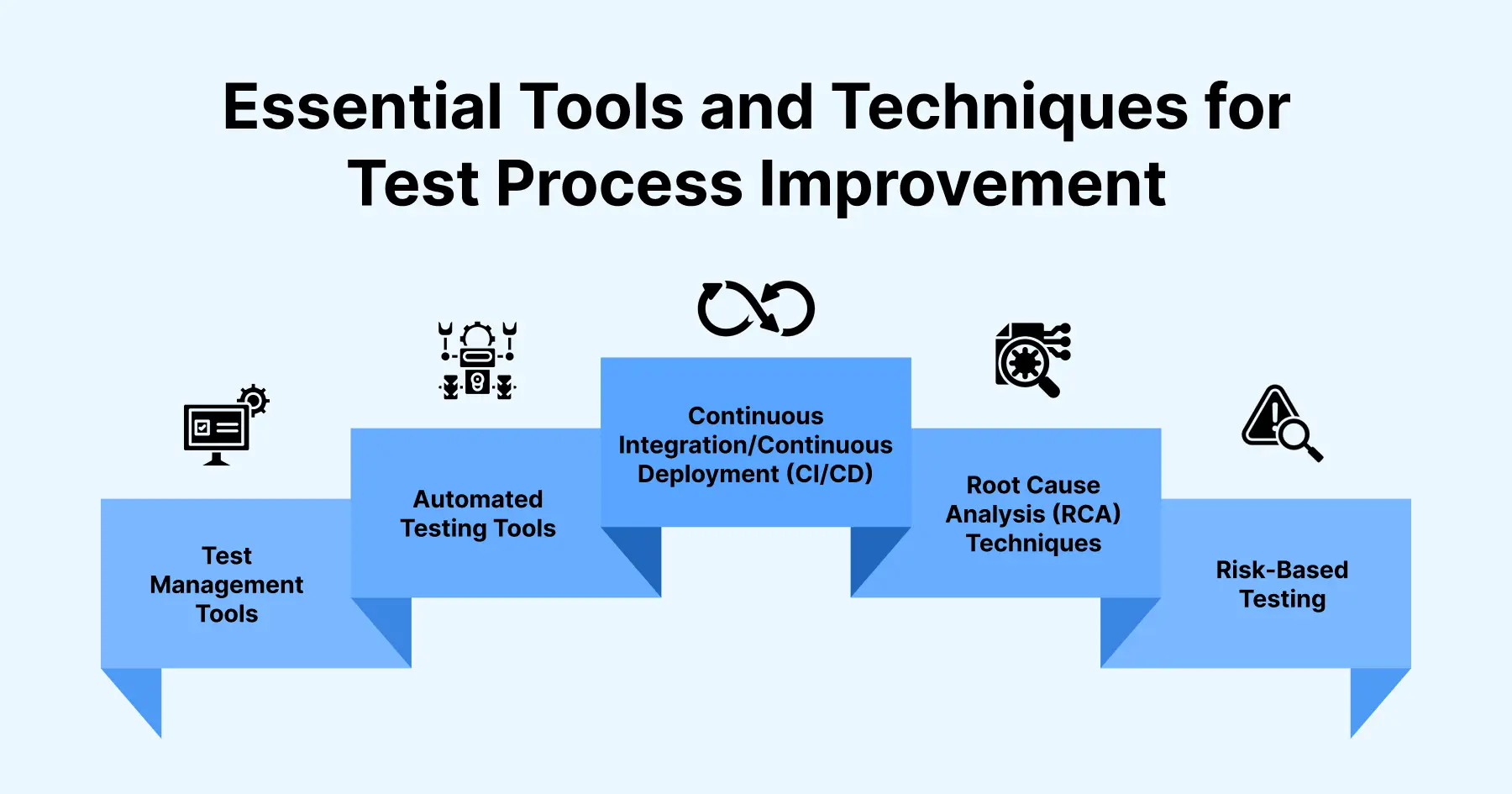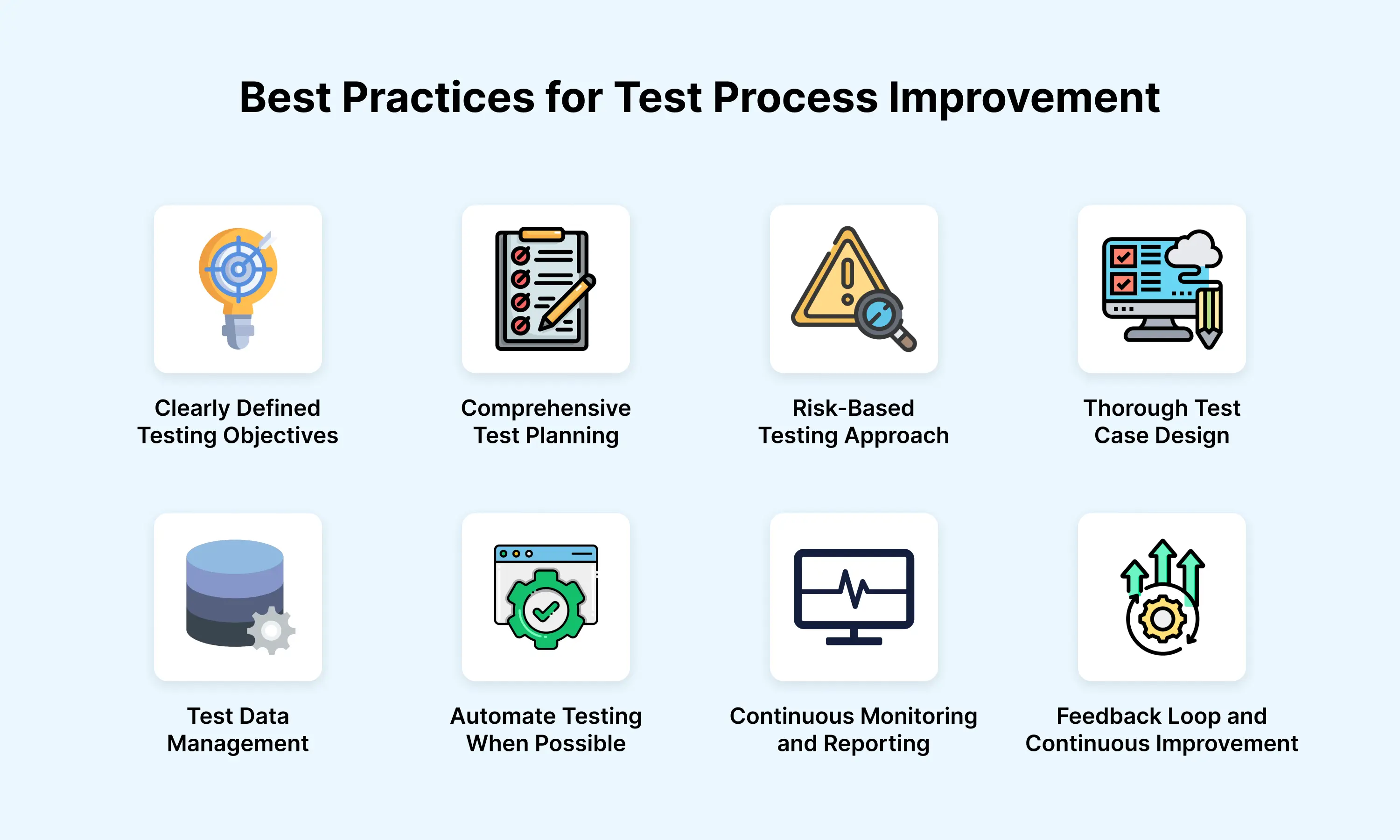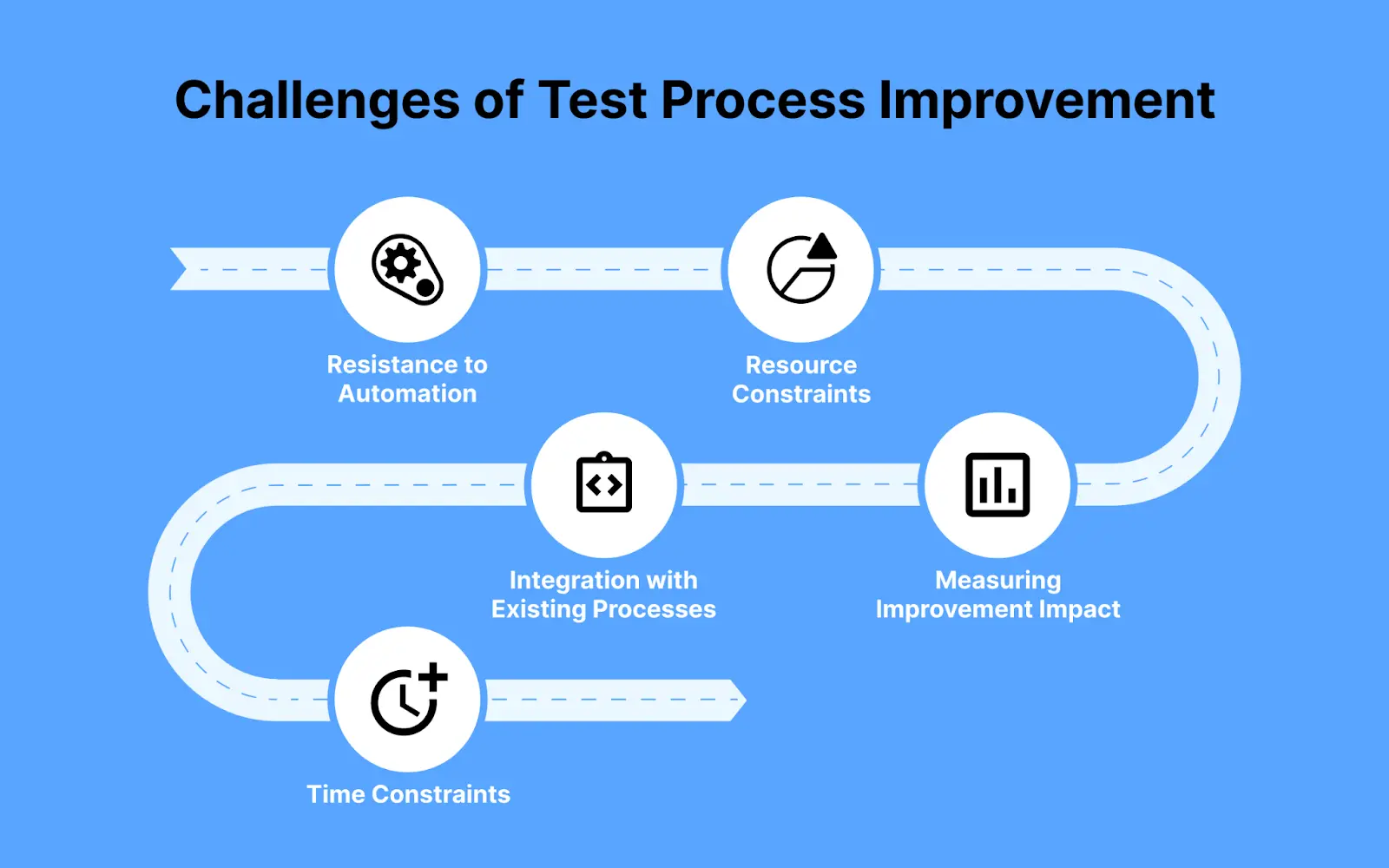- Automation
- Home
- /
- Learning Hub
- /
- Test Process Improvement
- -
- September 05, 2023
Test Process Improvement : With Examples And Checklist
Elevate testing with our comprehensive TPI guide. Learn objectives, tools, best practices, benefits, challenges, and future insights.
OVERVIEW
To make your software projects better, Test Process Improvement (TPI) has brought a new way of doing tests that has really changed things. TPI changes the game for companies looking for continuous improvement by streamlining test processes , coordinating with organizational priorities, and improving overall software quality.
The Ins and Outs of TPI will be covered in detail in this blog, along with some of its significant advantages and the reasons why modern businesses just must employ it.
Lets get started!
What is TPI(Test Process Improvement)?
TPI (Test Process Improvement) is a structured and systematic approach used to enhance the quality and effectiveness of software testing within an organization. TPI focuses on identifying weaknesses and areas for improvement in the testing process, tools, and resources, with the ultimate goal of improving the overall testing capability and software quality.

The TPI approach consists of a set of actions that organisations can take to evaluate their present testing practises, assess their strengths and shortcomings, create a personalised improvement plan, and gradually implement changes. Companies are able to improve their testing procedures over time because of this iterative process, which leads to higher-quality software and happier customers.
TPI places a strong emphasis on the necessity of continuous improvement in the testing procedure, acknowledging that testing is not a one-time endeavour but rather an ongoing endeavour to adapt and evolve alongside the increasing requirements and complexity of software development.
By using Test Process Improvement principles, businesses can make sure that their testing procedures stay up to date with industry standards and best practises, which will ultimately result in more dependable and durable software solutions.
Accelerate your Test Process Improvement. Try LambdaTest Now!
Objectives of Test Process Improvement
Organizations can better control their costs by implementing TPI objectives. By adopting Test Process Improvement principles, organizations can achieve better control over their testing efforts, enhance collaboration among teams, and ultimately deliver high-quality software products to their customers. The key objectives of TPI include:
- Assessment: TPI starts with an in-depth assessment of the existing testing processes, methodologies, and practices within the organization. This evaluation helps to identify strengths, weaknesses, and areas for improvement.
- Goal Setting: Based on the assessment results, specific improvement goals are set to address the identified weaknesses and enhance the testing process. These goals are usually aligned with the organization's overall software quality objectives.
- Improvement Actions: After defining the improvement goals, actionable plans are developed to implement changes and enhancements to the testing process. This may involve adopting better testing techniques, utilizing advanced testing tools, investing in training and skill development for the testing team, and improving communication and collaboration between development and testing teams.
- Monitoring and Evaluation: TPI is an iterative process, and the implemented improvements need to be continuously monitored and evaluated. This allows organizations to measure progress, identify potential bottlenecks or challenges, and make further adjustments as required.
- Continuous Improvement: TPI is not a one-time effort; it is an ongoing and evolving initiative. Continuous improvement is at the core of TPI, where organizations strive to make iterative enhancements to the testing process to adapt to changing project requirements and industry best practices.
Benefits of Test Process Improvement
Test Process Improvement (TPI) offers numerous advantages to organizations striving to enhance their software testing practices. By identifying weaknesses and optimizing the testing process, TPI brings significant benefits that lead to improved software quality, increased efficiency, and streamlined project execution. In this section, let’s explore the key benefits of Test Process Improvement and understand how it contributes to the overall success of software development projects.
- Improved Test Efficiency and Effectiveness: By identifying and addressing weaknesses in the testing process, Test Process Improvement leads to more efficient and effective testing activities. This results in better software quality, reduced defects, and improved overall project outcomes.
- Seamless Coordination: Test Process Improvement ensures that testing activities are aligned with organizational priorities and other project activities. This coordination facilitates smoother project execution and better collaboration between teams. Here are 24 top team collaboration tools for software testing teams.
- Enhanced Value of Testing: Implementing Test Process Improvement elevates the value of testing within the organization. It demonstrates the importance of testing in producing high-quality software and contributes to improved customer satisfaction.
- Reduced Downtime and Minimized Mistakes: As the testing process becomes more robust, the likelihood of critical errors and downtime decreases. This leads to more reliable and efficient operations, benefiting both the development team and end-users.
- Adherence to Industry Standards: Test Process Improvement encourages organizations to follow industry norms and best practices. Compliance with recognized standards ensures that testing is conducted in a structured and reliable manner.
- Sustainable Cost Savings: Over time, Test Process Improvement can lead to cost reduction in testing efforts. By optimizing testing practices, organizations can save resources and achieve sustainable cost savings in the long run.
- Accelerated Project Schedules:Streamlining the testing process can shorten testing cycles, allowing for faster project completion. This acceleration can lead to earlier product releases and improved time-to-market.
- Effective Evaluation of Improvement Efforts:Test Process Improvement provides a framework for assessing the impact of improvement efforts. By measuring and analyzing results, organizations can gauge the success of their improvement initiatives and make data-driven decisions for future enhancements.
Essential Tools and Techniques for Test Process Improvement
In the dynamic world of software development, ensuring top-notch software quality is crucial for the success of any product. Test Process Improvement (TPI) is a powerful approach that helps organizations continuously enhance their testing practices, resulting in better software quality and customer satisfaction. To achieve this, various tools and techniques play a pivotal role in streamlining the testing process and identifying areas for improvement. In this blog, we'll explore some essential tools and techniques that can empower your organization to elevate its testing capabilities and deliver exceptional software products.

- Test Management Tools:
To successfully improve the test process, test management must be effective. Teams can effectively plan, carry out, and monitor testing operations using test management solutions like Jira, TestRail, and HP ALM (Application Lifecycle Management). With the help of these technologies, testers and developers may work together more effectively as they have a single location to handle test cases, track defects, and report progress. Teams are better able to decide wisely, spot bottlenecks, and streamline testing efforts using real-time insights and data
- Automated Testing Tools:
The game-changer in test process improvement is automation testing. Teams may automate time-consuming and repetitive test cases using tools like Selenium, Appium, and JUnit, freeing up testers to concentrate on more important scenarios. Automation broadens the scope of tests, quickens the testing process, and improves the accuracy of test results. Additionally, it makes early bug discovery easier, which lowers the expense and work needed to correct flaws.
- Continuous Integration/Continuous Deployment (CI/CD):
Implementing CI/CD pipelines guarantees that software be released more quickly and frequently without sacrificing quality. The processes for building, integrating, and deploying software are automated by tools like Jenkins, GitLab CI/CD, and CircleCI. Organizations may do continuous testing, identify issues early, and establish a smooth and reliable deployment process by integrating automated tests into the CI/CD pipeline.
- Root Cause Analysis (RCA) Techniques:
Effective test process improvement depends on discovering the underlying causes of failures. The 5 Whys, Fishbone Diagrams (Ishikawa Diagrams), and Pareto Analysis are RCA methodologies that aid teams in learning more about the causes of defects and testing difficulties. By addressing the underlying causes, businesses can stop problems from reoccurring and produce software that is more dependable and of high quality.
- Risk-Based Testing:
It is not feasible to test everything thoroughly. The application's essential regions that are most likely to have flaws are where risk-based testing helps concentrate testing efforts. In order to prioritise test cases based on possible impact and likelihood of failure, testers might use tools like Risk Assessment Matrices and Risk-Based Testing Models. This guarantees the best possible use of testing resources and the quick recognition of high-risk problems.
Best Practices for Test Process Improvement
An essential component of test process improvement (TPI), test process management (TPM) enables businesses to streamline their testing procedures and produce high-quality software. The efficiency and efficacy of testing activities can be greatly increased by implementing best practises in TPM, improving software quality and customer satisfaction. We'll go over a few crucial, simple-to-understand recommended practises in this article that will enable your company to flourish at test process management and software testing.

- Clearly Defined Testing Objectives:
For each project, start by defining clear and detailed testing objectives. The scope, priorities, and test coverage of the software development effort should be based on these objectives, which should also be in line with the project's overall aims. A focused and effective testing process depends on having well defined objectives.
- Comprehensive Test Planning:
Make an extensive test strategy that describes the testing approach, scope, resources, and timeframes. Make sure that all parties are on the same page by incorporating business analysts, testers, and developers in the planning phase. Throughout the project lifetime, a well-organized test plan acts as a roadmap for the testing team and promotes efficient cooperation.
- Risk-Based Testing Approach
Based on a risk analysis, prioritise testing efforts. Testing should be concentrated on the essential components of the programme that are most likely to have flaws. You may optimise resource use and make sure that high-priority functionalities get the attention they need by using a risk-based testing methodology.
- Thorough Test Case Design:
Create thorough, in-depth test cases that cover all possible scenarios, edge cases, and failure spots. Maximising test coverage and increasing the likelihood of finding faults early in the development cycle are both benefits of effective test case design.
- Test Data Management:
Make that the information needed to run test cases successfully is present in your test environment. When test data is managed properly, delays are avoided, and testers may concentrate on testing rather than finding or creating test data.
- Automate Testing When Possible:
Utilise test automation for time-consuming and repeated test cases. Automated testing improves productivity, facilitates quicker test execution, and lowers the possibility of human error. Select the proper test cases for automation, keeping in mind that not all tests can be automated.
- Test Execution Insights
"Test Execution Insights" involve gathering crucial data during software test execution. These insights track progress, identify defects, assess performance, and gauge software quality. They encompass test case statuses, defect details, execution times, coverage analysis, and regression results. Real-time monitoring, data analysis, collaboration, and strategy adjustments based on these insights enhance decision-making and contribute to effective Test Process Improvement (TPI).
- Continuous Monitoring and Reporting:
Keep stakeholders updated through frequent testing activity monitoring and thorough test reporting. Making data-driven decisions for process improvement with effective reporting facilitates trend identification, fault tracking, and trend detection.
- Feedback Loop and Continuous Improvement:
Encourage open discussion and feedback among the testing team members and other stakeholders. Analyse test results, obtain comments and pinpoint areas that need improvement on a regular basis. Adopt a culture of continuous improvement to improve testing procedures and performance as a whole.
Challenges of Test Process Improvement
Test Process Improvement (TPI) is a vital initiative for organizations aiming to enhance software quality and optimize testing practices. While TPI promises numerous benefits, it also presents a set of challenges that must be addressed effectively to ensure successful implementation. In this section, we will explore the key challenges that organizations often encounter during Test Process Improvement and discuss strategies to overcome these hurdles for improved testing outcomes.

- Resistance to Automation: Embracing automation is crucial for TPI success, but some team members may resist its implementation due to concerns about job security or lack of familiarity with automated tools.
- Integration with Existing Processes: Integrating TPI efforts with pre-existing development and testing processes can be complex, particularly in organizations with well-established workflows.
- Time Constraints: The pressure to deliver projects within tight deadlines may limit the time available for comprehensive TPI efforts, potentially hindering thorough process improvement.
The Future of Test Process Improvement
In today's fast-paced and technology-driven world, software testing plays a pivotal role in ensuring the delivery of high-quality products and exceptional user experiences. As we look to the future, the landscape of test process improvement is evolving rapidly, embracing cutting-edge technologies and innovative methodologies. In this section, let’s explore the exciting developments shaping the future of test process improvement, paving the way for more efficient, accurate, and streamlined testing practices.
AI-Driven Test Automation
Test automation is about to undergo a revolution as a result of artificial intelligence (AI), which will make it smarter and more adaptive than ever. AI-powered testing systems can analyse enormous volumes of data, spot trends, and generate test cases on their own. These tools can self-optimize thanks to machine learning algorithms, which lower maintenance requirements and increase test coverage. Testing teams can concentrate on jobs that have a higher economic value as repetitive and time-consuming tests are automated which speeds up the testing process as a whole.
Shift-Left Testing and DevOps Integration
The future of test process improvement lies in embracing the concept of Shift Left testing, where testing activities start earlier in the software development life cycle. Collaborating closely with development teams, testers can catch defects at the source and provide real-time feedback, fostering a culture of continuous testing and improvement. Integration of testing within the DevOps pipeline further streamlines the process, enabling quicker feedback loops, faster deployment cycles, and enhanced collaboration among cross-functional teams.
Test Data Management Innovation
The future of testing includes advanced test data management solutions that cater to the complexities of modern applications. With the increasing need for realistic and diverse test data, data virtualization and synthetic data generation techniques will become more prevalent. These technologies offer secure and compliant data provisioning, reducing data-related bottlenecks and ensuring faster test execution.
Blockchain in Testing
Blockchain technology is not limited to cryptocurrencies; it also holds great potential for enhancing the integrity and security of software testing processes. With its immutable and decentralized nature, blockchain testing can verify test results, maintain a transparent test history, and prevent unauthorized modifications. This will lead to increased confidence in test outcomes and more reliable auditing capabilities.
IoT and Performance Testing
As the Internet of Things (IoT) spreads, it is essential to guarantee the best functioning of linked devices. Performance testing will focus on scalability, responsiveness, and load handling across multiple connected devices in order to address the problems faced by IoT ecosystems. By simulating real-world circumstances, advanced test frameworks can help organisations find performance bottlenecks and provide flawless IoT experiences.
Conclusion
Test Process Improvement (TPI) is a crucial strategy for achieving testing excellence in software development. By placing a strong emphasis on continuous improvement, TPI empowers teams to identify and address flaws in their testing procedures effectively.
Through Test Process Improvement, organizations can streamline testing efforts, reduce project risks, and shorten time-to-market for their software products. As the demand for higher software quality and efficiency continues to rise, adopting the Test Improvement Process becomes essential for organizations striving to deliver exceptional products and stay competitive in the market. By leveraging the objectives of TPI and continually refining their testing practices, businesses can pave the way for a successful and impactful software development journey. Thus, to stay ahead in a landscape that is quickly changing, adopting the Test Improvement Process becomes essential.
On this page
- Overview
- What is TPI(Test Process Improvement)
- Objectives of Test Process Improvement
- Benefits of Test Process Improvement
- Essential Tools and Techniques for Test Process Improvement
- Best Practices for Test Process Improvement
- Challenges of Test Process Improvement
- The Future of Test Process Improvement
- Frequently Asked Questions (FAQs)
Frequently asked questions
- General
Author's Profile

Vishal kumar Sahu
Vishal, a tech enthusiast and Digital Marketer at LambdaTest, is on a continuous learning journey in the dynamic field of software testing. His passion for quality assurance is evident in his dedicated approach to mastering the intricacies of testing methodologies. Recently joining LambdaTest, Vishal is captivated by the fascinating world of QA and software testing. With a relentless pursuit of knowledge, he embraces challenges, contributing to LambdaTest's commitment to excellence in the ever-evolving landscape of technology.
Reviewer's Profile

Harshit Paul
Harshit is currently the Director of Product Marketing at LambdaTest. His professional experience spans over 7 years, with more than 5 years of experience with LambdaTest as a product specialist and 2 years at Wipro Technologies as a certified Salesforce developer. During his career, he has been actively contributing blogs, webinars as a subject expert around Selenium, browser compatibility, automation testing, DevOps, continuous testing, and more.
Did you find this page helpful?
More Hubs
Try LambdaTest Now !!
Get 100 minutes of automation test minutes FREE!!

 Christmas Deal is on: Save 25% off on select annual plans for 1st year.
Christmas Deal is on: Save 25% off on select annual plans for 1st year.








